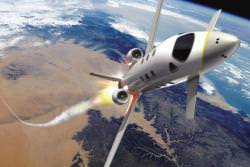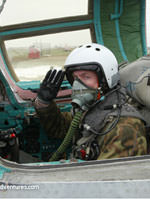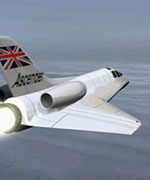With ‘space tourist’ Mark Shuttleworth heading to the International Space Station this month, and other visits in the pipeline, space looks like being a busy place in 2002. But Tony Webb, founder of eSpaceLotto.com, wants to make it even busier. He talks about his program for raising the funds needed to make space tourism a reality for all.
Read the Article
With ‘space tourist’ Mark Shuttleworth heading to the International Space Station this month, and other visits in the pipeline, space looks like being a busy place in 2002. But Tony Webb, founder of eSpaceLotto, wants to make it even busier. He talks about his program for raising the funds needed to make space tourism a reality for all.
In the wake of Dennis Tito’s inaugural tourist flight to the International Space Station in April 2001, the busy parade of space tourists to the Station this year includes South African Internet millionaire Mark Shuttleworth and possibly N’Sync base guitarist Lance Bass. Space is becoming accessible to a wider group than just professional astronauts or cosmonauts but only to those who can afford the vast fees, or can raise them via promotion and publicity, thanks to their high profiles.
Tony Webb, founder of eSpaceLotto is a passionate advocate for making space tourism accessible to everyone, not just the rich and famous, and is using the ‘lotto’ concept to achieve this.
“I was looking for a global solution to expand space tourism – a space lottery – and to provide an opportunity for people everywhere to ‘play the game.’ The idea came to me when I watched a TV program on the Discovery Channel a few years ago on space tourism, and I worked thereafter on making this idea come to life. We’re all on the same planet, so why shouldn’t we all have a chance to visit space?”
The idea behind eSpaceLotto appears to be simple – pay your fee, nominate the space tourism organization you would like to help through allocation of 20% of your fee, and then be in the draw for a chance to go into space.
Webb’s not the only person to have thought of this way of funding space tourism on a large scale. Apollo astronaut Buzz Aldrin in an interview in Focus magazine, titled ‘I Want You in Space,’ spoke about innovative ways for people to become involved in the space program, and the general interest in gambling. “Given that almost anybody would love to go up in space, why not combine the two things to create a space lottery?”
Says Tony Webb, “The first thing to note is that everyone who purchases a ticket at eSpaceLotto can immediately allocate 20% of the cost of their ticket (less processing fees) to an organization we are supporting. A few we have currently chosen include MirCorp, TGV Rockets, and Interorbital Systems, as well as the U.N. chartered World Space Week, whose activities around the world promote an interest and knowledge of space exploration.”
These organizations have a connection with space tourism and support for their activities will help to drive the industry according to Webb. The money for World Space Week helps fund the provision of Starry Night astronomy software to schools.
“Basically, we picked private aerospace companies and space related organizations that are doing outstanding work and that we would like to support. There are no limits to the number of private aerospace companies and space related organizations that we can support, and we would be happy to consider others.”
These select companies will have representatives reviewing the financial management and accountability of the eSpaceLotto drawings, says Webb, as a safeguard that the money will reach its target.
Jane Reifert of Incredible Adventures, one of the companies to receive support from eSpaceLotto, says, “We are honored that eSpaceLotto has chosen Incredible Adventures to supply MiG-25 ‘edge of space’ flights and zero-gravity adventures to lotto winners. We are especially looking forward to sending their first group of winners through our sixteen day Orbital Qualification Program.
“We offered our first civilian MiG-25 flight back in 1993. At that time, it was almost unheard of for someone to fly to the edge of space. Now, less than a decade later, we can arrange for civilians to visit the International Space Station.
“Several months ago, a survey conducted on our website showed strong support for a ‘space lottery’. We think a well-run, legally operated, ‘space lottery’ could go a long way toward providing the funding necessary to make incredible space adventures available to everyone.”
Randa Milliron, CEO of Interorbital Systems, agrees. “When Tony [Webb] came to us at Interorbital Systems with his brave new lottery concept, we found ourselves immediately in full support of the plan. Not only would he be providing prime publicity and great gaming opportunities, but he was also slinging another ‘ping’ at the world’s psyche, clearly pointing out that being Earth-locked is not the only game in town! If Tony’s venture pays off, he’ll be putting his money where his mouth is by creating a means for the general public to actually provide infusions of capital to a company like ours that’s offering space tourism opportunities. This sort of ‘gift’ will facilitate companies like ours becoming operational more quickly, which translates into more rapid access to space for eager adventure tourists. With the sort of cash flow the lottery promises, our orbital vacation packages can escalate to lunar vacation packages in a reasonably short timeframe.”
There are two competitions being run through eSpaceLotto Website – the weekly lottery and the raffle.
The first raffle involves a maximum of 10,000 “Special Offering” tickets being sold, with other raffles to follow.
For the space lottery, you need to pick between 3 and 5 correct numbers in the California Super Lotto draw each Wednesday to win a sixteen-day miniature cosmonaut training package valued at $200,000 and compete against nine other winners for the trip on the $20,000,000 Russian Soyuz rocket to space.
Webb explains the reasons for using the California Super Lotto numbers. “We could have drawn the numbers ourselves or had an independent firm do this for us but we felt that it was more transparent for all concerned to use a large, respectable lottery like the California Super Lotto. It is easy for players to check what the winning numbers are and there is no chance of error or confusion when it comes to the winning numbers.”
The price of each ticket is based on the odds of winning, according to the eSpaceLotto Website. The cost of each lottery ticket is $10, $30, $80 and $300 ($60 for the introductory Special Raffle). For example, for a $30 ticket, you need 5 out of 5 correct numbers to win. For the $300 ticket, you need 3 correct numbers out of 4. Each winning ticket may be auctioned at eSpaceLotto’s website for a cash-out option.
If a person wins the draw, they will be informed by e-mail and be required to provide evidence of identity. They may then have to wait for a period of up to 60 days to receive the miniature Cosmonaut training prize.
The lucky ten winners get to go to Star City in Moscow to compete for the chance to travel on a Russian Soyuz spacecraft to the International Space Station. While only one person may receive the chance to go the ISS, the remainder won’t lose out entirely. Webb says that they will be given the opportunity to fly on a seven day orbital flight with Interorbital Systems, which will be using its own Apollo-style capsules and its Neptune Orbital Spaceliner, a Titan II-Class Plus rocket. Launches are slated to begin in 2005, from Interorbital’s private spaceport and space tourism resort in the South Pacific Kingdom of Tonga.
Although the technology for some of these ventures has yet to be put into place, Webb does not see that as a problem. “These organizations are not kidding around. There are people there with brilliant minds and concepts that need to be supported. All they need is the funding to get it going. That’s part of the reason for doing this.”
Webb cautions that the person who eventually goes into space with the Russians will need to pass their medical tests and meet their physical requirements.
Webb projects that US$60-70 million will be raised from this global venture. So what’s the catch? What will happen if the required sums are not raised through the 10 lotteries or 10 raffles to obtain 10 immediate winners? And aren’t people risking their fee if the pool of funds raised isn’t large enough?
“That’s like saying no-one wants to go into space and we’ve all been fooling ourselves. I believe that globally speaking there are enough people out there who want to go into space to make this viable. Research has shown that 70-80% of people want to go to space and they will make this happen. This is their future. It’s [space tourism] a new industry, which represents potentially $100 billion a year.”
Webb has spent the last few years seeking legal opinions on global Internet gambling and says that the eSpaceLotto.com global project is legal and set up in full accordance with Belize Internet gaming laws. The company is headquartered outside Geneva in Switzerland. “Belize is a low tax country which does not have a tax on Internet wagers. This means that more money goes to space tourism and for the future of all mankind. In addition, many other countries are very protective of their national lotteries and will not allow any competition.”
The global space tourism lottery is now up and running, says Webb, and those interested in the concept can check out the website.
Pat Bahn, CEO of TGV-Rockets, which has also been nominated for support by the lotto money, says this is a concept that is long overdue. “I think it’s time for a space lottery to come to the [fore]front. Now that space tourism is a reality, the next thing is a lottery as a way to enable millions of people of modest means to participate in the exciting new venture for space travel.”
Jennifer Laing is a freelance space writer from Melbourne, Australia.



